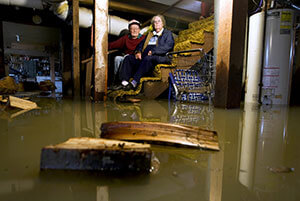Upgrade #1: Add a Sump Pump
A sump pump is needed as part of any corrective measure. The sump pump removes the footing drain water from around the basement wall and discharges it to the surface of the ground, a ditch, or a storm sewer, depending on the surface grading around the house. Many communities require that new homes include sump pumps. Sump pumps in new homes usually discharge to the storm sewer system.
To protect a basement from flooding due to sewer backup, the plumbing fixtures and floor drain in the basement also need to be disconnected from the municipal sewer.
A sump pump, including the basement fixture disconnection, can be installed in existing homes but each home is different.
Upgrade #2: Add a Sump Pump and Valves
If a sump pump is not sufficient, a check valve and a shut-off valve can be installed to provide a good measure of protection from basement flooding. These valves can isolate the house plumbing from the public sewer in the street. The check valve includes a flapper that shuts when water level in the public sewer is high enough to flow back into the house. The shut-off valve can be manually closed as an added measure of protection. The shut-off valve will also need to be closed if debris becomes lodged in the check valve preventing its full closure.
The homeowner will need to discontinue or, at least, sharply curtail the use of the sanitary facilities while the potential for flooding exists. During this time, showers, the clothes washer, and dishwasher cannot be used.
Both the sump pump and the valves can be installed in existing homes but each home is different.
Upgrade #3: Add a Sump Pump and an Ejector Pump
An ejector pump can provide still further protection. An ejector pump can be installed to pump the sewage into the public sewer whether it is flooded or not. If there is a power failure, the homeowner will need to discontinue use of the sanitary facilities.
Both the sump pump and the ejector pump can be installed in existing homes but each home is different.






